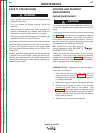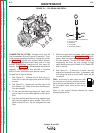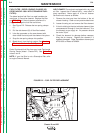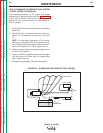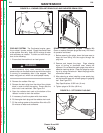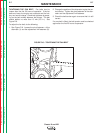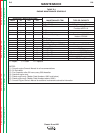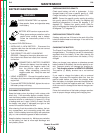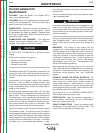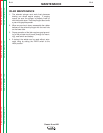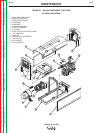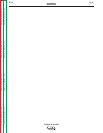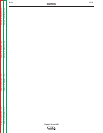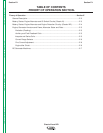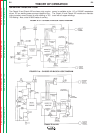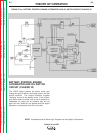
WELDER/GENERATOR
MAINTENANCE
STORAGE: Store the Classic III or Classic IIID in
clean, dry, protected areas.
CLEANING: Blow out the generator and controls peri-
odically with low pressure air. Do this at least once a
week in particularly dirty areas.
NAMEPLATES: Whenever routine maintenance is
performed on this machine - or at least yearly - inspect
all nameplates and labels for legibility. Replace those
which are no longer clear. Refer to the parts list for the
replacement item number.
COMMUTATOR AND BRUSHES: The generator
brushes are properly adjusted when the welder is
shipped. They require no particular attention.
DO NOT SHIFT THE BRUSHES or adjust the rocker
setting.
Shifting of the brushes may result in:
• Change in machine output
• Commutator damage
• Excessive brush wear
Periodically inspect the DC generator commutator, AC
exciter slip rings, and brushes by removing the covers.
DO NOT remove these covers while the machine is
running.
Commutators and brushes require little attention.
However, if they are black or appear uneven, have
them cleaned by experienced maintenance personnel
using a commutator stone. Never use emery cloth or
paper for this purpose.
Replace brushes when they wear within 1/4" of the pig-
tail. A complete set of replacement brushes should be
kept on hand. Lincoln brushes have a curved face to fit
the commutator. Have experienced maintenance per-
sonnel seat these brushes by lightly stoning the com-
mutator as the armature rotates at full speed until con-
tact is made across the full face of the brushes. After
stoning, blow out the dust with low pressure air.
Seat the brushes on the AC exciter as follows. Position
the brushes in place. Then slide one end of a piece of
fine sandpaper between slip rings and brushes with the
coarse side against the brushes. With slight additional
finger pressure on top of the brushes, pull the sandpa-
per around the circumference of the rings - in direction
of rotation only - until brushes seat properly. In addi-
tion, stone slip ring with a fine stone. Brushes must be
seated 100%.
Arcing or excessive exciter brush wear indicates a pos-
sible misaligned shaft.
Uncovered rotating equipment can be dangerous. Use
care so your hands, hair, clothing or tools do not catch
in the rotating parts. Protect yourself from particles that
may be thrown out by the rotating armature when ston-
ing the commutator.
Arcing or excessive exciter brush wear indicates a pos-
sible misaligned shaft. Have an authorized Lincoln
Electric Field Service facility check and realign the
shaft.
BEARINGS: The Classic III and Classic IIID are
equipped with double-shielded ball bearings having
sufficient grease to last indefinitely under normal ser-
vice. Where the welder is used constantly or in exces-
sively dirty locations, it may be necessary to add one
half ounce of grease per year. A pad of grease one
inch wide, one inch long, and one inch high weighs
approximately one half ounce. Over-greasing is far
worse than insufficient greasing.
When greasing the bearings, keep all dirt out of the
area. Wipe the fittings completely clean and use clean
equipment. More bearing failures are caused by dirt
introduced during greasing than from insufficient
grease.
CURRENT RANGE SELECTOR CONTACTS: The
contacts should not be greased. To keep the contacts
clean, rotate the current control handle through its
entire range frequently. Good practice is to turn the
handle from maximum to minimum setting twice each
morning before starting to weld. Never rotate the han-
dle while the machine is under load.
Put a drop of oil on the CURRENT RANGE SELEC-
TOR shaft at least once every month.
RECEPTACLES: Keep the electrical receptacles in
good condition. Remove any dirt, oil, or other debris
from their surfaces and holes.
CABLE CONNECTIONS: Check the welding cable
connections at the weld output terminals often. Be
sure that the connections are always tight.
MAINTENANCE
D-10 D-10
Classic III and IIID
Return to Section TOC Return to Section TOC Return to Section TOC Return to Section TOC
Return to Master TOC Return to Master TOC Return to Master TOC Return to Master TOC
WARNING
CAUTION



